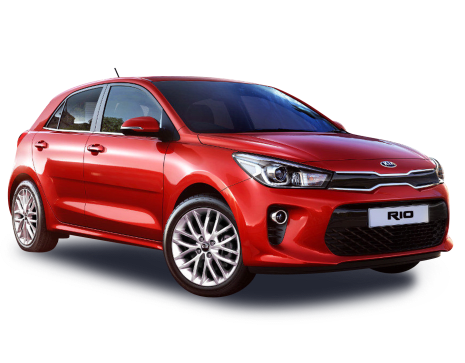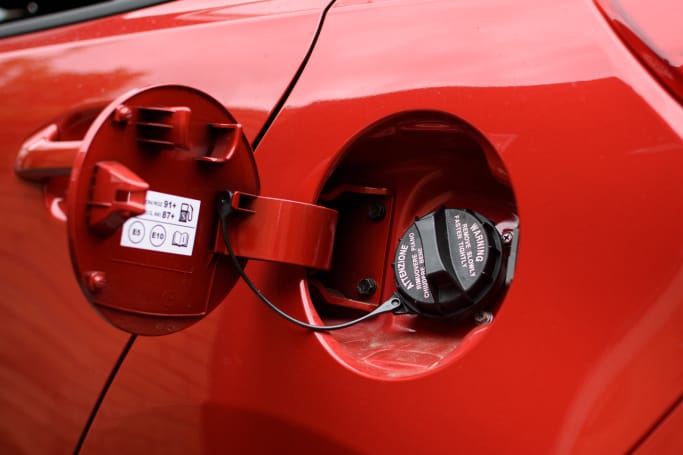
Suzuki Swift 2019 review
The Swift personifies Suzuki's ability to appeal to a diverse set of buyers across multiple markets. But, how does it measure up in the Australian market in 2019?
Browse over 9,000 car reviews
Over four generations, the Kia Rio has cemented its place in the Australian small-car landscape.
It now enjoys a market share on par with the Honda Jazz, but is bested by its fleet-friendly cousin, the Hyundai Accent, as well as the Suzuki Swift, Mazda2 and Toyota Yaris.
Now that it’s an established player, though, could it aim for a bigger slice of the small-hatch pie? Could it become one of Australia’s most beloved small-car nameplates?
We’ve driven the entire updated 2019 Rio range to find out.
| Kia Rio 2019: S | |
|---|---|
| Safety rating | |
| Engine Type | 1.4L |
| Fuel Type | Regular Unleaded Petrol |
| Fuel Efficiency | 6.2L/100km |
| Seating | 5 seats |
| Price from | $12,320 |
Price is everything in such a competitive segment, and so every dollar matters in the small-car stakes.
The Rio range is a three-variant affair, starting with the $16,990 base-model S. The S is unchanged from last year’s model and comes equipped with either a six-speed manual or an antiquated four-speed auto at a $2100 premium.

Standard inclusions on the S are 15-inch steel wheels, a 7.0-inch multimedia touchscreen with Apple CarPlay and Android Auto support, a reversing camera and halogen headlights with auto function.
Missing is cruise control or more recent systems like AEB, lane-keeping assistance, blind-spot monitoring, or cross-traffic alerts.
It’s worth noting the entry-level variants of the Honda Jazz, Mazda 2 Neo and Suzuki Swift are all cheaper, too. And the additional cost of $2100 for a lacklustre automatic is a particular let down.
The next grade up in the range is the new Sport variant ($17,790). The Sport replaces the previously-mid-spec Si, and it gains 17-inch alloy wheels, cruise control, a leather-bound steering wheel and gear shift as well as heated and folding wing-mirrors.

The Sport can also be had with a new six-speed torque converter automatic at a $3000 premium. This transmission is better, but it still can't make up for the failings of the engine; but more on that in the Driving section of this review.
Finally, the updated Rio range tops out with the GT-Line ($21,990). The GT-Line replaces the previous top-spec SLi and comes with an overhauled drivetrain and the presence of active safety features which are not available, even optionally, on lower grades.

The GT-Line gains a bespoke body-kit, flat-bottomed perforated-leather steering wheel, carbon-look interior trim, LED DRLs, fog lights and rear light clusters.
All Rio variants score a reversing camera with rear parking sensors.
The range, spanning from $17,790 to $21,990 is a decent one, but the safety and performance improvements of the GT-Line make it our pick of the range, and it's worth spending the extra money for one.

Just be aware that the GT-Line's circa-$22k pricing will put you in a car the next size up fairly easily.
It’s a shame both the S and the Sport do not get any active safety features and are burdened with antiquated (or expensive) automatic transmissions.

Design is a strong point for the Rio. This generation of car has been imbued with strong Germanic style courtesy of Kia’s skilful design boss.

The boxy shape and well-defined lines make any variant in the range look ready to take on the Volkswagen Polo, and the plastic detail finishes are largely tastefully executed. But it’s a shame about the dorky hubcap-clad steel wheels in the base car.

Inside, the Rio’s cabin is easily one of the best in the segment. It has a primo-looking dash with tasteful patterns and colours. The 7.0-inch touchscreen taking pride of place in the dash lends a modern feel to the unit, and the steering wheel could easily be borrowed from the far more expensive Stinger sedan.

A simple dial cluster and low-seating make the cockpit a reasonably nice place to be in any variant. But as good as it looks, the interior is hard materials galore, so don’t expect stellar comfort for your elbows or knees on long drives.
Manuals make the lack of knee room obvious, as taller folks can be susceptible to bashing their knee on the steering column during clutch operation.
The seats are executed in a tasteful pattern and are reasonably comfortable, but offer hardly any side support, even in the GT-Line.
Other than the GT-Line’s carbon-look touches and bespoke seat trim, there is little difference between the interior design of each variant.
The Rio still easily possesses a better looking and more ergonomic cabin than the Swift, Yaris and Jazz.
The Rio’s square dimensions lend it a spacious interior, although it is surprisingly bested in this class on boot space by several competitors.

Arm-flailing space and headroom is great for all occupants, but rear passengers get perhaps better legroom than even the driver.

There are well-sized bottle holders in each door, as well as two small ones for front occupants in front of the console box.
Speaking of which, it’s impressive this little car gets a console box at all, because the Jazz and Yaris are left without, while in the Mazda2 it’s a $495 option.
There’s also a decently sized trench in front of the gearknob which houses the USB, AUX and 12v ports. The Rio doesn’t get rear air vents, but it does have a USB power outlet in the back.

Boot space is a decent 325 litres VDA which sounds and looks good, but is bested in this segment by the Honda Jazz (354L), Suzuki Baleno (355L) and Hyundai Accent (370L).
It maxes out at 980L with the rear seats flat, which is almost double the equivalent room in a Suzuki Swift.

There are two engines and four transmissions in the Rio Range. But only one combination is likely to put a smile on your face.
The S and Sport are only available with a 1.4-litre four-cylinder non-turbo petrol engine which produces 74kW/133Nm. That sounds competitive on paper, but in real life it fails to deliver.

Both cars come with the same six-speed manual, but the S can be optioned with an ancient four-speed auto at a $2100 premium. This is an antiquated transmission and not good value.
The Sport is available with a six-speed auto at a $3000 premium. It’s a much better transmission and improves the drive experience, but it's expensive for an auto and cannot make up for the engine’s failings.
Up the top of the range is the much more impressive 1.0-litre three-cylinder turbo in the GT-Line.

The GT-Line is not available with a manual and can only be had with a seven-speed dual-clutch transmission, a first for Kia in Australia.
The engine produces 88kW/172Nm but can make use of its peak torque in a much wider band than the 1.4. Combined with the slick-shifting dual clutch it's a much better combination.
The 1.4-litre manual variants of the S and Sport have a claimed/combined fuel usage figure of 5.6L/100km. The S’ four-speed auto has a claimed figure of 6.2L/100km and the Sport’s six-speed has a figure of 6.0L/100km.
Meanwhile, the three-cylinder turbo offering in the GT-Line with the seven-speed auto has the best claimed figure of the lot, at 5.4L/100km.

In my test of the S and Sport I found a more realistic figure to expect from the 1.4-litre to be between 7.5 and 9.0L/100km. This is generally worse than fuel figures we’ve experienced in cars like the Suzuki Swift and Mazda2.
My test of the GT-Line produced an 8.9L/100km figure, but I was having a lot of fun.
All Rios have 45-litre tanks and drink base-grade 91RON unleaded petrol.
The Rio has some excellent, and some not-so-excellent driving characteristics.
It’s frustrating, really, because all Rios have a nice wide footprint, solid steering and excellent suspension tuned here in Australia.
The downside is the drivetrains in most variants can’t live up to the promise laid out by the rest of the experience.
The outdated 1.4-litre feels breathless until torque starts to arrive somewhere around 4000rpm. In manual versions, this means you’ll be shuffling gears with annoying frequency to try and keep the power up. In the four-speed auto S you’re left with no choice but to be stuck without power, then suddenly too much power, while the six speed in the Sport helps to smooth this out a little.
All 1.4-litre variants feel slow off the line no matter what you do. Overtaking is a chore.

The new 1.0-litre three-cylinder unit in the GT-Line is a different story altogether. It’s an enthusiastic little engine with a wide power band. It does have a small amount of lag to contend with, but it sounds gruff and has a heap more character than most engines in this class.
It’s not quite on the same level as the Suzuki Swift Sport, but performance-wise, it's a rung above competitors from other brands.
Basic Warranty
7 years / unlimited km warranty
ANCAP Safety Rating

All Rio variants carry a maximum five-star ANCAP safety rating from 2017 onwards. Although, safety across the range varies geatly.
The entry-level S and Sport have no active safety items whatsoever, even optionally. This is a roaring shame given even base variants of the Swift and Mazda2 have AEB, and it is available as an affordable option on the Toyota Yaris.
The GT-Line, again, is far superior to the others in that it comes standard with city-speed auto emergency braking (AEB), forward collision warning, lane keep assist (LKAS) with lane departure warning (LDW), and driver attention alert (DAA).
No Rio variant is capable of supporting blind spot monitoring (BSM), rear cross-traffic alert (RCTA) or active cruise control.
Standard fitment across the Rio range is the standard suite of stability controls, six airbags and three top-tether or two ISOFIX child-seat mounting points.
One of the Rio’s strong points has always been Kia’s fantastic seven-year unlimited kilometre warranty. It far outstrips the now-standard five-year warranties offered by other brands.
While other brands are upping the pace, the Rio still has the best warranty in this class.

The same can’t be said for ownership costs, sadly. The Rio only needs to be serviced once a year or every 15,000km, and costs an average of $390.71 per year for 1.4-litre variants, or a significantly more expensive $484.57 per year for the GT-Line.
The Rio is a well-designed and spacious hatch with excellent multimedia and a classy cabin.
It’s a shame the S and the Sport, with their dated engine and expensive automatic options, can’t live up to the otherwise fantastic road manners on offer.
That leaves the GT-Line as our pick of the range. With its fun-packed drivetrain and expanded active safety offering, it’s hard to look past as the Rio of choice.
| Vehicle | Specs | Price* | |
|---|---|---|---|
| S | 1.4L, ULP, 4 SP AUTO | $12,320 – 16,390 | 2019 Kia Rio 2019 S Pricing and Specs |
| Sport | 1.4L, ULP, 6 SP MAN | $11,110 – 15,290 | 2019 Kia Rio 2019 Sport Pricing and Specs |
| GT-Line | 1.0L, ULP, 7 SP AUTO | $16,280 – 20,900 | 2019 Kia Rio 2019 GT-Line Pricing and Specs |
| Price and features | 7 |
|---|---|
| Design | 8 |
| Practicality | 7 |
| Under the bonnet | 6 |
| Efficiency | 7 |
| Driving | 7 |
| Safety | 7 |
| Ownership | 7 |
$12,990
Lowest price, based on 117 car listings in the last 6 months